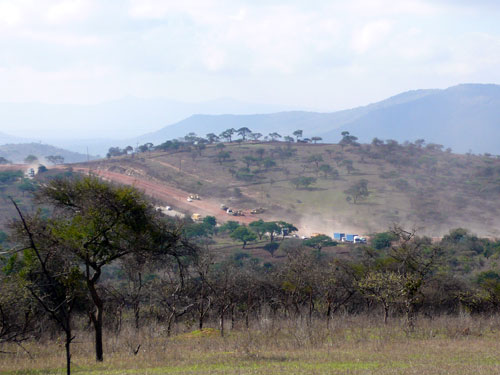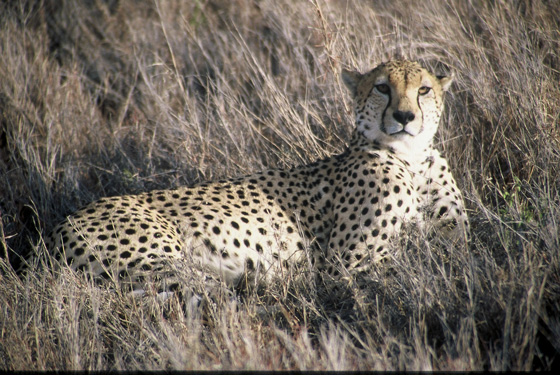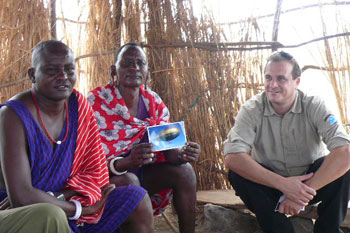|
Kenya
Salama, Kenya, October 2011
The "battle" of the cheetahs
Flying over Salama I don't see much that gives me hope for the survival of cheetahs in Kenya, and yet... During my first visit here more than five years ago the countryside was much more homogeneous, more regular. But the big ranches are disappearing little by little, subdivided by the government, taken over illegally by more and more people searching for new land. Where are the gigantic Euphorbia that I loved to perch on just a few months ago? Cut, like so many other trees.
The Mombasa Highway that cuts through this area is used more frequently since it has been improved and the excessive speed of the cars and trucks that take it make it even more of a hazard. On top of that, the rapid construction of the Malili Technopolis has reduced wildlife habitat.
According to my hardworking friends at Action for Cheetahs in Kenya, who continue their satellite following of the local population, during the past few months, sadly, many cheetahs have been killed while trying to cross the road.
The situation is not much better for the people living here. Drought, like in the entire Horn of Africa, has ravaged a land already weakened by irregular rainfall. Poor water management, increased mono-culture and deforestation do not offer much opportunity to fight the chronic water shortage.
Then why believe in the survival of cheetahs here? Personally, looking at it from my height of a few centimeters, I think that Man's future and that of these beautiful felines are very closely linked to Salama.
The disappearance of cheetahs does not bode well for the local community. It signifies an irreparable damage to the eco-system, with even more soil erosion, a lack of water and progressive desertification. Problems insupportable for families already stricken by difficult conditions.
For cheetahs, if the "Battle of Salama" is lost, their habitat will be further reduced, hill by hill. A scenario that has already been played out in Northern Kenya where people can name the date that the last cheetah was seen. For an animal like the cheetah that can not survive only in national parks because of competition from other predators, it is a race against the clock to stop them from disappearing altogether in Kenya. That race starts here, in Salama.
We must hope that Salama will be able to keep it's role as an ecological corridor and that the children in this quickly evolving region will have the will and assistance necessary to take control of their destiny, here where their parents have failed. We have discussed several possible solutions with the people here, but it is necessary to fight if they are to become a reality and turn against the destructive tendency that reigns.
My cheetah friends confirm that their life in Salama is very stressful and the situation is critical, especially with young to raise. This morning I left one of my little orange feathers next to the youngest cub, Tumaini ("Hope" in Swahili). He played with it and then it floated away, far, towards the people, like a secret message, a SOS.

Salama, Kenya: Children and cheetahs, big winners of the first EAFC tournament.
The inaugural Eco-Sys Action Football Cup (EAFC) tournament brought together 10 villages and more than 500 people in Salama, Kenya. Focused on the cheetah, which is slowly disappearing in this area due to habitat loss and continuing conflicts with farmers, it was a huge popular success.
Through a new and positive way the local population was able to learn how to better understand this feline. The event brought together Action for Cheetahs in Kenya (ACK) and Eco-Sys Wana Duma (Eco-Sys Action Association in Kenya).
A cycling race was held the day after the tournament with my friends Adeline and Olivier on our way to Cape Town during our Tandafrika adventures.
Read more in the complete file of the tournament.

Stéphane Rousson scouting Kenya for locations, November 2008
Adventurer Stéphane Rousson, who attempted the crossing of the English Channel with his muscle-powered balloon, was in Kenya and visited Eco-Sys Action projects there. He was accompanied by Laurence Latour who is working on his book, a great poetic text called "A la lisière de l'Utopie".
Stéphane Rousson was scouting Kenya to find suitable locations for his documentary project with his balloon. Among sites of interest were the Great Rift Valley, the cradle of humanity, Lake Magadi in Maasailand and Diani Beach on the Indian Ocean.
Photos of this trip are available on Stéphane's blog at http://zeppy-kenya.skynetblogs.be
Tree planting, Salama, Kenya, May 2008
Eco-Sys Action started a portion of its pledge to UNEP Billion Tree Campaign by planting 1,000 trees in the Salama area in Kenya. This is a preliminary operation to test the soil and sensibilize kids to their environment. As Mary Wykstra, Cheetah Conservation Fund Kenya Director, says, "It helps communities understand that the environment which supports carnivores is the same environment which sustains the livelihood of the people."
Four schools were selected in the Salama area and each tree is taken care by a group of students. A presentation on trees and the environment was given to them by a botanical specialist while an educational program was set up to help them understand the role of predators in the ecosystem.
Indigenous Acacia sp., Lucena, Cassia saimea, Balanites sp. and decorative Neem and Jacaranda were among the species planted. The project will expand to set up tree nurseries and a similar action in the Samburu area with the Ewaso Lions Project. More than tree planting, it's the awareness raised by every single tree that makes this Salama project with kids so special.
About 1,000 more trees have also been planted at two cattle dips where CCF initiated a campaign to improve livestock health and therefore show farmers the benefits brought about by preserving cheetah habitat. Because land divisions in the last 20 years have caused deforestation and reduced water supplies in this area, new trees and the ongoing program to reforest part of this ecosystem have given hope for a better future for both the community and the wildlife.
United Nations for Environment (UNEP), Nairobi (Kenya), February 2008
The Eco-Sys Action International Conservation Football Cup (ICFC) has been officially endorsed by the United Nations for Environment (UNEP). This is a major support for the ICFC that aims at raising environmental awareness and gathering funds for sustainable projects around the world through football tournaments organized in Europe, the Middle East and Hong Kong and in developing countries.
UNEP has recognized Eco-Sys Action action as being in line with its strategy on Sport & Environment. Read more. The ICFC will be held in 2009 and will show how football can bridge cultural differences and help meaningful projects on the ground that will positively impact both local communities and their eco-system.
Wil Raymakers visits Eco-Sys (ESWD) in Kenya, November 2007
World-acclaimed cartoonist Wil Raymakers was the special guest of the foundation and launched the ESWD "Art for Kidz" project. Wil shared lots of humorous stories and it was a great time for all. Kids were overwhelmed by his "Ox Tales" stories which are some of the funniest tales in the animal kingdom. His books have been a fantastic communication tool, and definitely show that humour has no borders and can be appreciated by everyone!
United Nations for Environment (UNEP), Nairobi (Kenya), May 2007
Eco-Sys Action pledged to plant 100,000 trees to support the "Billion Trees Campaign" launched by UNEP under the patronage of Prince Albert II of Monaco and Nobel Peace Prize winnerWangari Maathai.
The Eco-Sys Action project will not only involve tree planting, but will also include establishing nurseries and a sustainable medicinal plant microbusiness to ensure long-term benefits for the local communities involved. Most of the planting will take place in Kenya around cheetah habitat. See more.
|
All Post
Indonesia
Hong Kong
India
Qatar
Africa (By Flight)
Burkina Faso
Botswana
Purple Cake Day
Happy World Sparrow Day!
A Connected World
The battle of the cheetahs
Passion to Live
Scubster, from dream to dive.
The world's rarest shark!
The Eco-Sys Action Football Cup (EAFC) in Kaw, French Guiana wins the Jean Roland Prize.
A wink from Jean-Pierre Papin
Archives
July 2012
June 2012
May 2012
April 2012
March 2012
October 2011
September 2011
June 2011
April 2011
March 2011
February 2011
December 2010
October 2010
August 2010
June 2010
March 2010
Categories
|
|










